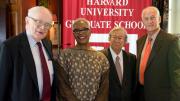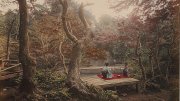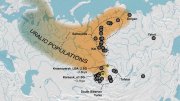The Graduate
School of Arts and Sciences Centennial
Medal, first awarded in 1989 on the occasion of the school’s hundredth
anniversary, honors alumni who have made contributions to society that emerged
from their graduate study at Harvard. It is the highest honor the Graduate
School bestows, and awardees include some of Harvard’s most accomplished alumni.
The Graduate School of Arts and Sciences
2011 Centennial Medal Winners
Heisuke Hironaka, Ph.D. ’60, mathematics
Heisuke Hironaka is that rare scholar whose professional successes are made up almost equally of groundbreaking discoveries in his field and tangible work to bring the excitement of such discoveries to life for younger generations.
A mathematician who trained under Harvard’s influential and discipline-shaping Oscar Zariski, Hironaka went on to become one of the leading algebraic geometers of his time. He rose to fame in 1964 for his work on the “resolution of singularities,” one of the most fundamental, and most difficult, problems in mathematics. Taking a “strikingly original approach,” as the American Mathematical Society later noted, Hironaka “created new algebraic tools and adapted existing ones” to solve this long-unsolvable problem. In recognition of that achievement, in 1970 he received the Fields Medal, often called the Nobel Prize of mathematics.
After taking up appointments at Brandeis and Columbia, Hironaka returned to Harvard in 1968 to join the faculty of the Mathematics Department, where he currently holds the rank of Professor Emeritus. Beginning in 1975, he assumed a joint professorship at Kyoto University, and he later became director of the Research Institute for Mathematical Sciences in Kyoto. From 1996 to 2002, he was president of Yamaguchi University, returning to the prefecture where he was born.
Hironaka is widely esteemed in his home country, to a degree that American mathematicians might both envy and find hard to believe. In 1970 he was elected to the Japan Academy, which recognizes the country’s most eminent researchers and scholars in the sciences, and in 1975 he was awarded Japan’s top cultural prize, the Order of Culture, by the Japanese government. The latter accolade turned him into a popular celebrity, a stature he has used to exert broad influence on Japanese society and education.
Between 1977 and 1991, Hironaka wrote or co-authored 26 popular books on topics including discovery in science, the education of children and young adults, creative thinking, and mathematics. In 1980, he started a summer seminar for high school students, and later added one for Japanese and American college students, and he founded the Japanese Association of Mathematical Sciences to support those efforts as well as graduate study and research abroad by Japanese mathematicians. According to Shing-Tung Yau, the chair of Harvard’s Mathematics Department, Hironaka’s fundraising efforts on behalf of the association, which even included TV commercials, resulted in major support from corporations such as Mitsubishi and Fuji, and eventually the Japanese government.
“In the 1980s there were few domestic grant opportunities for foreign travel or exchange,” says Yau. “Today, one can see the fruits of Hironaka’s efforts in the number of former JAMS fellows who have become professors of mathematics across the United States and Japan.”
Mark Spivakovsky, now at the Mathematical Institute of Toulouse, was one of Hironaka’s Harvard advisees who benefited from those exchange opportunities. Hironaka “had a profound influence on my development not only as a mathematician but also as a person,” he says. “In addition to all the mathematics he taught me, all the ideas and insights that he shared with me, I am deeply grateful for the two fantastic years I spent in Kyoto as a graduate student under his guidance and care.”
Beyond all that he has accomplished, there is the joy Hironaka takes in mathematics. He once told an interviewer of the pleasure he found in counting—in simply counting numbers and comparing them. And he has said that his attraction to the singularities problem had all the logic, and ultimately all the mystery, of “a boy falling in love with a girl.” It has been a happy union indeed.
For answering the important questions in mathematics, for enabling countless
scholars to pursue mathematical research at the highest levels, and for helping
to spread the pure joys of mathematics to younger generations around the world,
we honor you today.
Jeffrey Alan Hoffman, Ph.D. ’71, astrophysics
To say that Jeffrey Hoffman has traveled far since his days as a graduate student at Harvard would be a gross understatement. To be somewhat more exact, he has traveled more than 21.5 million miles, as an astronaut on five Space Shuttle missions. Along the way he rescued one of astronomy’s—and the world’s—most important assets and brought alive the excitement of space exploration to several generations of impatiently earthbound students.
Today, Jeff Hoffman is not at all far away. In fact he is just down the river, at MIT, where he is Professor of the Practice of Aerospace Engineering in the Department of Aeronautics and Astronautics. But between 1978, when he was part of the first group of astronauts chosen for NASA’s new space shuttle program, and 1997, when he retired from the astronaut corps to become NASA’s European representative, he logged more than 1,200 hours in space.
He made the first contingency spacewalk of the Space Shuttle era in 1985, attaching a “fly-swatter” device to the Shuttle’s robot arm in an attempt to rescue a wayward satellite. He flew a dedicated astronomy mission in December 1992, on board Columbia. He was the payload commander for the first flight of the Tethered Satellite System in July 1992, and he flew again for the Tethered Satellite relaunch in 1996.
But his most important mission came in 1993. “The entire astronomical community will always be indebted to Jeff Hoffman for his principal role in the correction of the optical system of the Hubble Space Telescope,” says Giovanni Fazio, a senior physicist at the Smithsonian Astrophysical Observatory and a lecturer in the Astronomy Department. “After that very successful repair,” Fazio continues, “observations made by the Hubble Space Telescope have revolutionized our view of the universe.”
Hoffman was part of the team that “saved the Hubble,” says Josh Grindlay, the Robert Treat Paine Professor of Practical Astronomy, and a friend and colleague from their days as Harvard graduate students. In this “most famous and rewarding” Shuttle mission, as Grindlay calls it, Hoffman and his colleague did the spacewalk that put on the “corrective eyeglasses to restore completely the spectacular vision of the HST.”
Hoffman’s knack for reaching the highest heights — he is also a mountaineer, Grindlay reports — first showed itself in his dissertation project, which—in the very early days of gamma-ray astronomy—involved building a cosmic gamma-ray detector that was flown from a very-high-altitude balloon over Argentina. Today, his curriculum for students at MIT, where he has been since 2001, is full of similar flights of fancy—or, as Grindlay puts it, “hands-on opportunities”—unparalleled elsewhere—“to get their hardware into space.”
“In the fifty years since the Mercury astronauts were selected, the nature of ‘The Right Stuff’ has changed,” says Hoffman’s colleague and friend Laurence R. Young, the Apollo Program Professor of Aeronautics and Astronautics at MIT. The astronaut ideal has shifted from “the macho test pilot to the highly skilled space scientist who could fix anything—even in the vacuum of space, 250 miles above the surface of the Earth,” Young continues. “Jeff Hoffman is the epitome of this new breed of astronaut.”
Now, with the Space Shuttle era set to end this summer, the chapter of US space history that Hoffman helped to write is also ending. It remains to be seen what the future of space exploration will hold, but it is almost certain that the students Hoffman has mentored, the skills he has taught—and the hardware he has gotten into space—will define that future, paving the way for our next great voyages of discovery.
For helping to open our eyes to the wonders of space travel, for daring rescue
missions that pushed the horizons of our knowledge of the universe, and for
training younger generations to play leading roles in future voyages of
discovery, we honor you today.
Richard Wall Lyman, Ph.D. ’54, history
When Richard Lyman arrived at Stanford as an associate professor of history in 1958, Stanford Magazine recalls, the pastoral setting and sleepy campus prompted a colleague to comment that anyone in search of intellectual excitement would have to travel 50 miles to Berkeley.
By the time Lyman became Stanford’s Provost, in 1967, and President, in 1970, that tranquility was a thing of the past. He was confronted with some of the most contentious campus protests of a volatile era, as student activists rose up against the Vietnam War, military research activities, and University governance. The activism turned violent in 1968, when protesters burned the headquarters of the naval ROTC and vandalized the office of the outgoing University president. At a critical moment in 1969, when students had occupied Stanford’s Encina Hall, which housed sensitive student records, Lyman was forced to call in the police. As he recounts in his recent memoir, Stanford in Turmoil, one night rocks flew through the windows of his campus home, a room away from his sleeping daughter.
Through it all, Lyman remained steady and strong, willing to make hard choices, confident in the conviction that Stanford must recover and prosper. And so it did.
“His capacity to deal with episodes that involved confrontation, threat, and abusive language was a remarkable triumph of patience and reason,” says Donald Kennedy, a fellow Harvard Ph.D. who succeeded Lyman as President of Stanford in 1980, when Lyman left to become president of the Rockefeller Foundation. Kennedy goes on: “I will always be grateful that he left me the lightened load of inheriting a campus where conscientious but civil dispute could flourish in an environment supporting commitments to serious work in scholarship.”
Derek Bok, Harvard’s president during those years, says Lyman’s good judgment was widely acknowledged beyond Stanford, too. “He was certainly held in great esteem by all his peers during his presidency of Stanford as one of the outstanding academic leaders of that period,” says Bok.
It is Lyman’s commitment to the academic business of the University — easy to overlook in the turmoil of the times — that many of his colleagues most prize. Professor Walter Falcon, who succeeded him as director of Stanford’s Freeman Spogli Institute for International Studies in 1991 (and who also holds a Harvard Ph.D.), praises Lyman’s “integrity, his Maine-like common sense and humor, his personal empathy combined with his analytic toughness, and his sense of history. Many Stanford colleagues remember Dick primarily for his firm guidance of the University during the chaos of the early 1970s. I remember him most for the role he played in removing barricades of a different sort — the walls around departments and schools — thereby facilitating new forms of interdepartmental research and teaching.”
Indeed, says William Miller, the Herbert Hoover Professor Emeritus and Lyman’s successor as Stanford’s Provost, he led the University at a remarkable time, a time during which its academic prominence grew dramatically, and when new interdisciplinary programs were just arising — forerunners, Miller says, of the many “multidisciplinary programs and institutes that today are attacking major societal problems.” Miller concludes, “Richard Lyman is a man of high principles and deep dedication to the core academic values of the university.”
Leadership, Lyman has written, “requires different qualities at differing times, and sometimes some of the qualities needed are not among those generally considered admirable.” And yet today, with full admiration, we salute you.
For your courageous institutional leadership during a tumultuous time in US history, for your commitment to the core principles of higher education, and for expanding our understanding of how universities can connect scholars across disciplines for the benefit of society, we honor you today.
Nell Irvin Painter, Ph.D. ’74, history
As a historian, teacher, cultural critic, and now in a budding career as an artist, Nell Irvin Painter has approached the world around her with an uncommon empathy and a gift for bold strokes.
Her instinct has been to value and connect the experiences of those historically undervalued actors in our American narrative: black people, native people, women, working people, and poor people. Her inclusivity—her commitment to the stories of everyday people—has been courageous, groundbreaking, and sometimes controversial. Most important, it has led to the creation of a new way of doing history—one that, through the students she has mentored, has imprinted itself on historical scholarship everywhere.
Nell Irvin Painter is the Edwards Professor of American History, Emerita, at Princeton University, where she was the director of the Program in African American Studies from 1997 to 2000. Her prominence was recognized in her selection as president of the Southern Historical Association for 2007 and as president of the Organization of American Historians for 2007–08. Her books include Creating Black Americans (Oxford University Press, 2006) and Southern History Across the Color Line (University of North Carolina Press, 2002). Her newest book, The History of White People (W. W. Norton), was published in March 2010 and has just appeared in paperback.
Before coming to Princeton, she was on the faculty at the University of Pennsylvania from 1974 until 1980 and at the University of North Carolina at Chapel Hill through 1988. Widely esteemed as a teacher and mentor, she has advised numerous dissertations and helped many other young scholars navigate the minefields of professional development. In 2000, the American Historical Association awarded her the Roelker Mentorship Award in recognition for this work.
“Where historians are taught to build by tearing down, Nell Painter has always exemplified an alternative model,” says one of her former doctoral advisees, Walter Johnson, now the Winthrop Professor of History and Professor of African and African American Studies at Harvard. “Her scholarship and teaching are characterized by a sort of everyday veneration: for the scholars like W. E. B. Du Bois, Carter Woodson, and Herbert Guman who pointed the way in black history; for the slaves, the coal miners, and the caretakers whose labor built the United States; for the communists, the convicts, and lonely visionaries who bore the stigma of wanting it to be a better, brighter, more humane place.”
In Painter’s scholarship, says Johnson, “the recondite idioms of academia are made accessible to the general listener, and the wisdom of the folk is presented as not just knowledge, but cutting-edge knowledge.”
Another former Princeton student praises Painter’s rare ability to spark the scholarly passions and creativities of those she touches. “Her work has pushed the conceptual boundaries of American history,” says Chad Williams, now an associate professor at Hamilton College, “and she has likewise challenged her students to do the same. Nell’s rare combination of intimidating brilliance and selfless commitment to the intellectual, professional, and personal development of her students has ensured that her legacy will continue to be felt throughout academia for generations.”
Now she is shaping a new legacy, starting over as a self-described “lowly graduate student” at the Rhode Island School of Design, where she will receive an MFA next month. Her decision to launch this new chapter—she earned a BFA degree in painting from Rutgers in 2009—manifests the same embrace of possibilities, and the same openness to risk and experimentation, that has defined her historical approach over the decades of her first career. We hope that this next chapter will be equally fulfilling.
For writing history that values and connects the experiences of all Americans, for showing the influence of the marginalized on our national narrative, and for changing the practice of historical scholarship through your inspirational mentoring, we honor you today.






